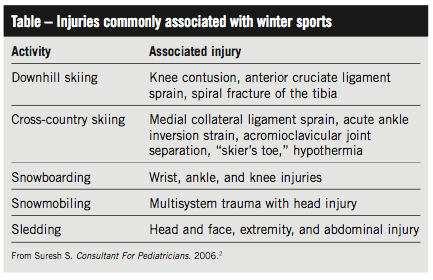Tips to Help Prevent Winter-Related Injuries
Primary Care Update
Brief Summaries for Clinical Practice
Sledding down a snowy hill, skating on a frozen pond, cross-country skiing along a woodland trail—these wintertime activities can pose the risk of frostbite and traumatic injury, particularly for children. Some of the injuries commonly associated with winter sports are listed in the Table.
The American Academy of Pediatrics (AAP) provides useful tips for avoiding cold injury, which are summarized here.1 These recommendations can help prevent the effects of overexposure to the cold and serious injury that can result from reckless participation in winter activities.

PREVENTING INJURIES FROM WINTER ACTIVITIES
Advise parents to set reasonable time limits on outdoor play to prevent hypothermia and frostbite, and have children come inside periodically to warm up. For adolescents and adults, the use of alcohol or drugs before any winter activity, such as snowmobiling or skiing, is dangerous and should not be permitted in any situation.
Ice skating. Skate on approved surfaces only. Check for signs posted by local police or recreation departments, or call your local police department to find out which areas have been approved.
Children should be advised to:
•Skate in the same direction as the crowd.
•Avoid darting across the ice.
•Never skate alone.
•Not chew gum or eat candy while skating.
•Wear a helmet.
Sledding. It is crucial to keep children away from motor vehicles while sledding and to have a supervising parent present at all times. Parents can also do the following:
•Keep young children separated from older children.
•Have child sled feet first or sitting up, instead of lying down head-first, or wear a helmet and goggles.
•Use steerable sleds (with well-lubricated steering mechanisms), not snow disks or inner tubes, and structurally sound sleds that are free of sharp edges and splinters.
•Ensure that sled slopes are free of obstructions and are covered in snow (not ice), are not too steep (slope of less than 30 degrees), and end with a flat runoff.
Snow skiing and snowboarding. Children should be taught to ski or snowboard by a qualified instructor in a program designed for their age group. They should never ski or snowboard alone. Young children should always be supervised by an adult. Older children’s need for adult supervision depends on their maturity and skill. If older children are not with an adult, they should always at least be accompanied by a friend.
All skiers and snowboarders should wear helmets. Ski facilities should require helmet use, but if they do not, parents should enforce the requirement for their children.
Equipment should fit the child. Skiers should wear safety bindings that are adjusted at least every year. Snowboarders should wear gloves with built-in wrist guards. Eye protection or goggles should also be used.
Slopes should fit the ability and experience of the skier or snowboarder. Children and adolescents should avoid crowded slopes and avoid skiing in areas with trees and other obstacles.
Snowmobiling. The AAP recommends that children younger than 16 years not operate snowmobiles and children younger than 6 years never ride on snowmobiles.
Protective measures include the following precautions:
•Do not use a snowmobile to pull a sled or skiers.
•Wear goggles and a helmet approved for use on vehicles, such as motorcycles.
•Travel at safe speeds.
•Never snowmobile alone or at night.
•Stay on marked trails, away from roads, water, railroads, and areas with pedestrians.
1.American Academy of Pediatrics. Winter Safety Tips. January 2012. www.aap.org/wintersafetytips. Accessed January 3, 2012.
2. Suresh S. Winter sports injuries: patterns of injury—preventive measures. Consultant For Pediatricians. 2006;5(3):168-175.


